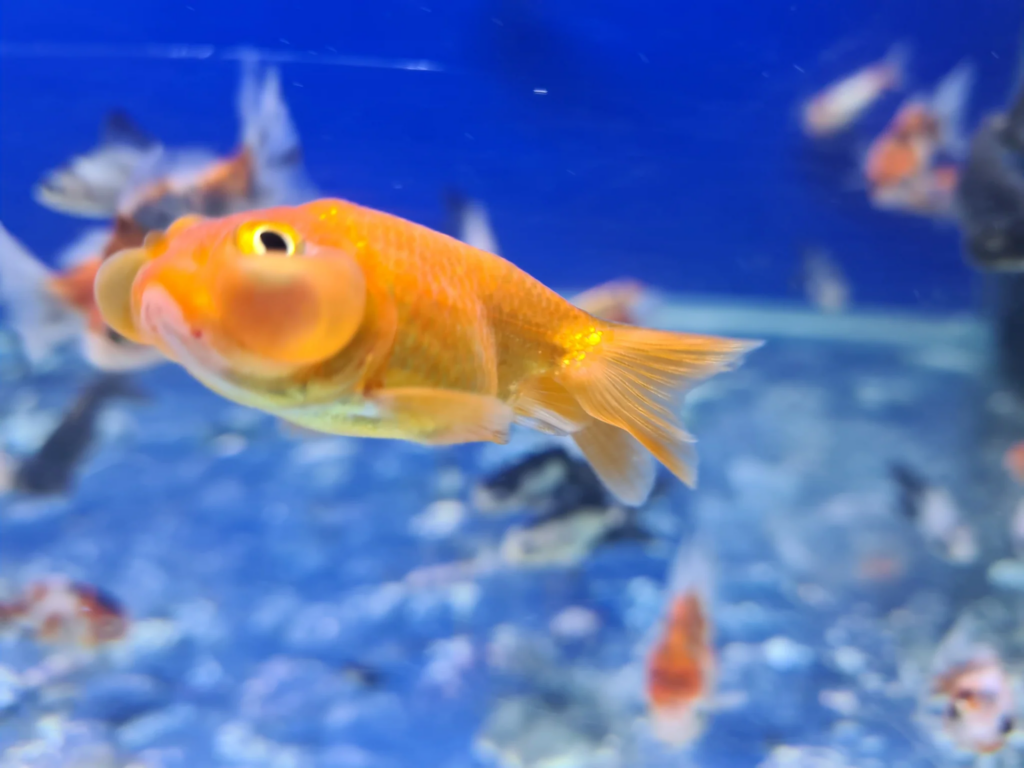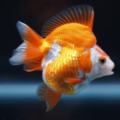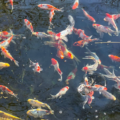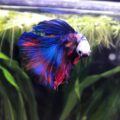The Celestial Eye goldfish is a quirky-looking and captivating species of fancy goldfish. This ornamental fish has fascinating vertically affixed telescopic eyes. Its unique eye shape and orientation give it its name because its eyes appear pointed towards the sky. This unique feature is why fish hobbyists and pet owners around the world are enchanted by the celestial eye goldfish.

Celestial Eye Goldfish: Everything You Need to Know
In this guide, I’ll take you on a journey to discover the beauty of the Celestial eye goldfish, sharing tips on their unique features, care, and ways to keep them healthy.
History and Origin

The origin and history of Celestial eye goldfish can be traced back to the late 1800s and early 1900s. It is believed to have originated from wild Prussian carp ancestors in Japan.
Initially, the wild carp were bred to be eaten, but fish keepers noticed a few orange fishes swimming with the gray carp. Over the years, more color variations and shapes of the celestial eye goldfish have been developed through selective breeding.
By the 19th century, this goldfish was traded across Asia, Europe, and the United States as an ornamental aquarium fish. Breeding this unique species has since been a popular hobby among aquarists.
Physical Characteristics

The celestial eye goldfish is a variety of fancy fish with unique physical traits.
Its most distinctive feature is its eye structure, which protrudes from the side of its head, keeping it in a fixed upward-gazing position.
The position of its eyes gives it its odd shape, and its retina’s prominence makes this species susceptible to retinal degeneration.
It has a short, round, egg-shaped body with a double anal and caudal fin. Its body shape gives it a unique, streamlined appearance that commands attention. This species comes in a stunning variety of color patterns.
You can find them in colors ranging from gold to orange, black, blue, and even shades of white. The celestial goldfish’s appearance is striking, with fins that fan out elegantly and scales that glisten, adding to their beauty.
Care Requirements

For your pet to develop properly and live a long, happy life, follow these care tips:
- Tank Size: The tank conditions of the celestial eye goldfish are an important parameter to focus on. You must provide a tank large enough to accommodate your goldfish and allow them to swim freely. This species needs a tank of at least 10 gallons.
- Water Conditions: Celestial eye goldfish are cold-water fish needing optimum water parameters. The water temperature must be around 65-75°F. This is important because this species won’t tolerate temperatures below 60°F. The pH level of the water needs to be about 6.0-8.0 with a water hardness of 5-19 dGH.
- Diet: Celestial eye goldfish are omnivores and can eat a wide range of foods. The diet for celestial eye goldfish could include protein, algae and plant matter. Meals that include fresh vegetables, bloodworms, or brine shrimp are great examples.
Proper fish care involves paying close attention to your pet and committing to a strict tank maintenance schedule to keep this elegant goldfish healthy. Without maintaining proper water parameters, the tank’s water quality can degrade, which can cause a wide range of issues from cloudy aquarium water to illness and mass fish die off.
Common Health Issues
Celestial eye goldfish are typically an active species and display signs of curiosity. When healthy, their scales are intact and vibrant without discolorations. Changes in celestial eye health can be noticed in their behavior, feeding habits, and appearance.
They are susceptible to a few health issues, including swim bladder diseases and bacterial and fungal infections. Their eyes, being their most unique feature, are susceptible to degenerative diseases that affect their retinas, causing them to go blind slowly.
The celestial eye goldfish can live 10 to 12 years or potentially longer if cared for properly and effective preventive care measures are adopted.
These care measures include maintaining high-quality water, regular water changes, and a balanced diet. If you notice any unusual behavior, early disease management should be done to keep your pet alive and healthy.
Breeding Information
Breeding celestial eye goldfish can be a rewarding process. The peak breeding time for this species is springtime, mostly because of the increasing temperatures.
These temperature changes are a breeder’s guide to finding the right time and season for efficient breeding.
To stimulate spawning, you can replicate these temperature changes in your tank by gradually increasing the water temperature and providing high-quality meals.
The breeding process begins when the males begin to chase the females around; this is the best time to set up a different tank for the offspring and prepare for fry care.
You may need a ratio of two females to one male goldfish to achieve a successful breeding process.
Telling both sexes apart may be difficult; however, the males tend to develop white tubercles on their gill covers and heads when in breeding conditions.
After fish reproduction, separating the fry and putting them in the newly set-up tank is essential to prevent the parent goldfish from eating them.
Compatibility with Other Fish
Celestial eye goldfish are sociable and group-oriented goldfish that enjoy the company of their kind, as do other fancy goldfish.
Their compatibility with other species makes finding suitable tank mates easier. If you want to build a community tank, it’s best to house your goldfish with other slow-moving species that thrive in similar water conditions.
Avoid overcrowding your fish, and make sure you get a tank large enough for proper aquarium cohabitation. Regular monitoring and adjustment are key to maintaining a peaceful habitat.
Behavior and Temperament

This species’ behavior is similar to that of other slow-moving goldfish. The celestial eye goldfish personality can be described as peaceful and sociable.
They have calm temperaments and high activity levels and enjoy moving around the tank for food.
Watching their social interaction is a fascinating experience because they thrive in the company of their kind and swim in harmonious groups.
Setting Up the Ideal Aquarium
An ideal aquarium setup involves providing ample swimming space for the celestial eye goldfish.
The recommended tank size should be 10 gallons for a single goldfish and at least 20 gallons for a pair. Tank decorations should resemble their natural habitat with substrate choices like fine gravel or fine sand and live plants.
Avoid objects or plants with sharp edges to avoid injuries to their eyes. Decorations like soft lights provide a serene environment and complement their color patterns.
Choosing the right filtration system also plays a crucial role in developing the ideal environment for your pet. Opt for a gentle yet effective high-quality filtration system to keep them clean and healthy.
Conclusion
Caring for a celestial eye goldfish is truly a unique experience. They are among the most captivating and rewarding underwater pets to keep.
However, because of the peculiarities in their care, many believe they are best for experienced fish keepers.
Celestial eye goldfish suitability depends on your love for this species and your willingness to give it the best care.
Regardless of the extra attention and care, it’s clear that aquarium enthusiasts can’t get enough of the rewarding experience of owning this beautiful creature.










